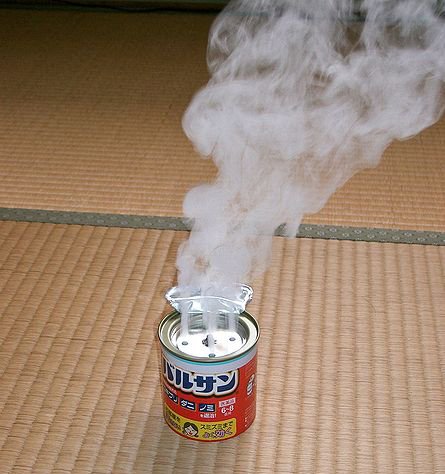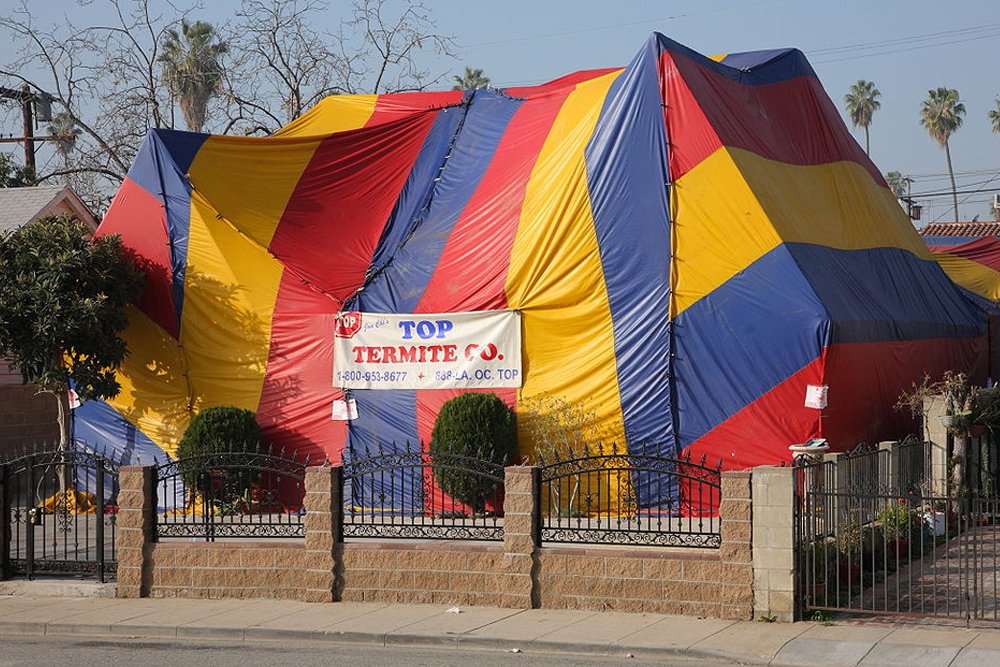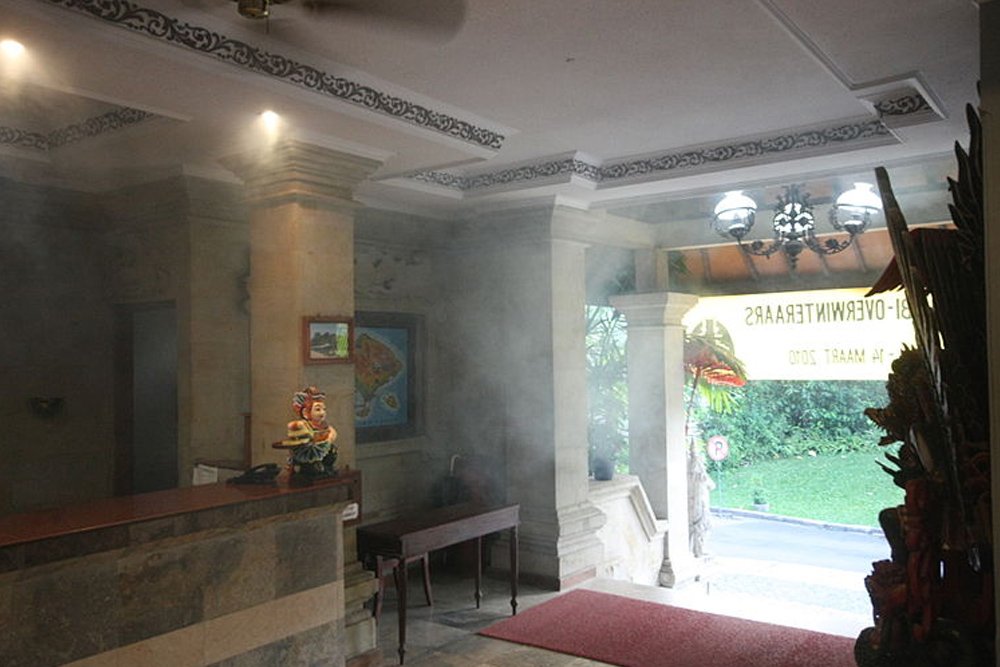Table of Contents (click to expand)
Fumigation is a process of pest control that involves filling an affected area with fumigants, or gaseous pesticides, in order to suffocate the pests. This method is typically used for agrarian applications, but is now also being used for structural fumigation in buildings. Structural fumigation is when a tarp is placed over a structure in order to contain the fumigants and allow them to penetrate through cracks and crevices to reach and exterminate pests such as bed bugs, drywood termites, and wood-eating beetles.
Fumigation is one of the most effective techniques of pest control. In fumigation, an affected area is completely filled with fumigants (gaseous pesticides) to asphyxiate the pests. Although fumigation techniques are conventionally used for agrarian applications, they are now being used as a pest control measure in buildings, which is also called structural fumigation. It is aptly called structural fumigation because this method affects the ‘structure’, implying that the pests inhabiting the structure are suffocated to death. These pests typically include woodborers and drywood termites.
What Are Fumigants?
Fumigants are gaseous pesticides that control pests in agricultural fields, structures like buildings and apartments, storage houses and various other sites. Fumigants are generally biocides—chemicals that can kill/injure living organisms with which they come in contact. Some fumigants also form parts of volatile organic compounds (VOCs). VOCs are dangerous compounds infamous for their contribution in the creation of smog. Sulfuryl fluoride, formaldehyde, methyl bromide, chloropicrin and iodoform are some of the most popular examples of fumigants. Let’s now take a look at some of the important chemical properties of fumigants and how they are relevant when deciding on the right fumigant.

Chemical Properties And Their Importance In Fumigation
- Vapor pressure: This is the pressure of fumigant vapor in equilibrium with its non-vapor (solid and liquid) phases at consider temperature. Fumigants like methyl bromide have a high vapor pressure, which implies that it is highly volatile and penetrates the environment quickly. However, after the Montreal protocol, the use of methyl bromide has been barred, given its role in ozone depletion.
- Boiling point: Boiling point is the temperature at which a liquid boils under a specific atmospheric environment. Fumigants with low boiling points are usually gases stored in high-pressure canisters. On the other hand, fumigants with high boiling points are usually liquid or solid at room temperature.
- Solubility: The solubility of fumigants is measured with respect to water. It is a measure of the maximum concentration of fumigant that dissolves under water at a specified pH and temperature. Ease of movement through the soil is heavily dependent on the solubility of the soil.
- Henry’s constant: This is the ratio of the concentration of fumigant in the air to its concentration in water at a specified temperature. The lower the value of Henry’s constant for a given fumigant, the more likely it will be dissolved into the soil-water matrix. On the other hand, having a higher value of Henry’s constant represents a propensity of the fumigant to stay in soil water films for a long period of time.
- Half-life: This is the time required for fumigants to degrade to one-half of its previous quantity. Half-life is an indicator of the persistence of a fumigant in the soil. The longer the half life value, the slower the rate of fumigant degradation from the soil.
Also Read: What Are Biopesticides?
What Is Structural Fumigation?
Structural fumigation is a pest control method for exterminating those pesky pests that are otherwise difficult to to control by conventional pest control methods, including spraying local insecticides/pesticides. It involves filling the airspace of a structure with fumigants. Generally, a tarpaulin is placed over the structure to contain the gaseous fumigants inside—such that these gases penetrate through cracks and crevices in the wooden furniture, closets, drawers etc. inside the contained region—to extirpate pests, such as bed bugs, drywood termites and wood-eating beetles. Most residents in warmer states like Florida, Hawaii, California etc. are familiar with the brightly colored tarps used to contain fumigants within structures.

Sulfuryl fluoride is the most popular choice of structural fumigation in many states. Fumigation using sulfuryl fluoride has been performed on residences, businesses and other structures for a couple decades now. Studies have shown that sulfuryl fluoride is a reliable method for the extirpation of urban infestations of wood-loving pests, such as termites, bed bugs and beetles. In California alone, 100,000 fumigations using sulfuryl fluoride are performed every year.
Also Read: How Do Bug Sprays (Like Raid And Baygon) Kill Cockroaches?
How Do They Fumigate?
Fumigation is a multi-stage procedure. The first step involves preparation. The infested area that needs fumigation is covered with a tarp or tent to create a sealed environment. Fruits, vegetables, food, and medications that are not enclosed in glass or metal packaging with the manufacturer’s original air-tight seal intact must be inserted into special bags provided by the fumigator company.

The second step is the main stage in which the actual fumigation is performed. The fumigant is released into the affected space. This space is then contained for a specific period (a couple of days, usually) with entry of individuals and their pets forbidden. This furlough allows the fumigant gas to percolate through the space in an effort to obliterate the infestation.
The third step involves preparing the space to be used in its normal way. This stage involves ventilation. The space is ventilated so that the toxic gases have a way to escape from the space. After all, the space must be reclaimed for normal living. The fumigator needs to test the air in each room using an Interscan to confirm aeration quality post-ventilation before permitting people to reoccupy the building. Once the fumigator finds that the toxic gases have left the space and the space is safe to inhabit again, they can allow the original occupants to move back into the space, which should be free from infestation!
How well do you know fumigation?

References (click to expand)
- Sulfuryl Fluoride Structural Fumigation Research. The Rausser College of Natural Resources
- Sulfuryl Fluoride Structural Fumigation. The University of California, Riverside
- Daft, J. L. (1991, March). Fumigants and related chemicals in foods: Review of residue findings, contamination sources, and analytical methods. Science of The Total Environment. Elsevier BV.
